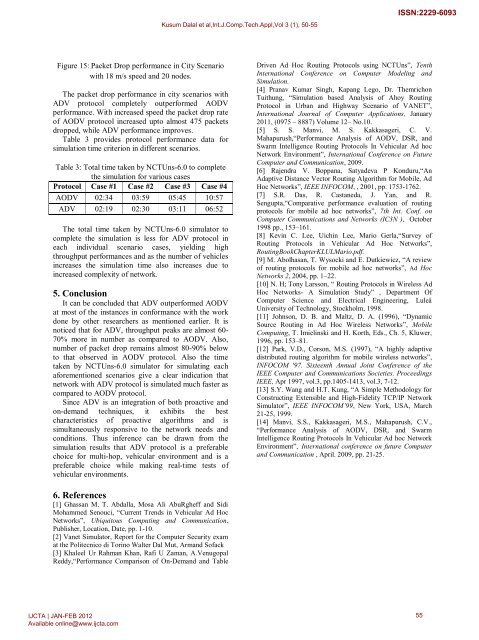Performance Evaluation of AODV and ADV Protocols in VANET ...
Performance Evaluation of AODV and ADV Protocols in VANET ...
Performance Evaluation of AODV and ADV Protocols in VANET ...
You also want an ePaper? Increase the reach of your titles
YUMPU automatically turns print PDFs into web optimized ePapers that Google loves.
Kusum Dalal et al,Int.J.Comp.Tech.Appl,Vol 3 (1), 50-55<br />
ISSN:2229-6093<br />
Figure 15: Packet Drop performance <strong>in</strong> City Scenario<br />
with 18 m/s speed <strong>and</strong> 20 nodes.<br />
The packet drop performance <strong>in</strong> city scenarios with<br />
<strong>ADV</strong> protocol completely outperformed <strong>AODV</strong><br />
performance. With <strong>in</strong>creased speed the packet drop rate<br />
<strong>of</strong> <strong>AODV</strong> protocol <strong>in</strong>creased upto almost 475 packets<br />
dropped, while <strong>ADV</strong> performance improves.<br />
Table 3 provides protocol performance data for<br />
simulation time criterion <strong>in</strong> different scenarios.<br />
Table 3: Total time taken by NCTUns-6.0 to complete<br />
the simulation for various cases<br />
Protocol<br />
<strong>AODV</strong> Name<br />
Case #1<br />
(m<strong>in</strong>.) 02:34<br />
Case #2<br />
(m<strong>in</strong>.) 03:59<br />
Case #3<br />
(m<strong>in</strong>.) 05:45<br />
Case #4<br />
(m<strong>in</strong>.) 10:57<br />
<strong>ADV</strong> 02:19 02:30 03:11 06:52<br />
The total time taken by NCTUns-6.0 simulator to<br />
complete the simulation is less for <strong>ADV</strong> protocol <strong>in</strong><br />
each <strong>in</strong>dividual scenario cases, yield<strong>in</strong>g high<br />
throughput performances <strong>and</strong> as the number <strong>of</strong> vehicles<br />
<strong>in</strong>creases the simulation time also <strong>in</strong>creases due to<br />
<strong>in</strong>creased complexity <strong>of</strong> network.<br />
5. Conclusion<br />
It can be concluded that <strong>ADV</strong> outperformed <strong>AODV</strong><br />
at most <strong>of</strong> the <strong>in</strong>stances <strong>in</strong> conformance with the work<br />
done by other researchers as mentioned earlier. It is<br />
noticed that for <strong>ADV</strong>, throughput peaks are almost 60-<br />
70% more <strong>in</strong> number as compared to <strong>AODV</strong>. Also,<br />
number <strong>of</strong> packet drop rema<strong>in</strong>s almost 80-90% below<br />
to that observed <strong>in</strong> <strong>AODV</strong> protocol. Also the time<br />
taken by NCTUns-6.0 simulator for simulat<strong>in</strong>g each<br />
aforementioned scenarios give a clear <strong>in</strong>dication that<br />
network with <strong>ADV</strong> protocol is simulated much faster as<br />
compared to <strong>AODV</strong> protocol.<br />
S<strong>in</strong>ce <strong>ADV</strong> is an <strong>in</strong>tegration <strong>of</strong> both proactive <strong>and</strong><br />
on-dem<strong>and</strong> techniques, it exhibits the best<br />
characteristics <strong>of</strong> proactive algorithms <strong>and</strong> is<br />
simultaneously responsive to the network needs <strong>and</strong><br />
conditions. Thus <strong>in</strong>ference can be drawn from the<br />
simulation results that <strong>ADV</strong> protocol is a preferable<br />
choice for multi-hop, vehicular environment <strong>and</strong> is a<br />
preferable choice while mak<strong>in</strong>g real-time tests <strong>of</strong><br />
vehicular environments.<br />
Driven Ad Hoc Rout<strong>in</strong>g <strong>Protocols</strong> us<strong>in</strong>g NCTUns”, Tenth<br />
International Conference on Computer Model<strong>in</strong>g <strong>and</strong><br />
Simulation.<br />
[4] Pranav Kumar S<strong>in</strong>gh, Kapang Lego, Dr. Themrichon<br />
Tuithung, “Simulation based Analysis <strong>of</strong> Ahoy Rout<strong>in</strong>g<br />
Protocol <strong>in</strong> Urban <strong>and</strong> Highway Scenario <strong>of</strong> <strong>VANET</strong>”,<br />
International Journal <strong>of</strong> Computer Applications, January<br />
2011, (0975 – 8887) Volume 12– No.10.<br />
[5] S. S. Manvi, M. S. Kakkasageri, C. V.<br />
Mahapurush,“<strong>Performance</strong> Analysis <strong>of</strong> <strong>AODV</strong>, DSR, <strong>and</strong><br />
Swarm Intelligence Rout<strong>in</strong>g <strong>Protocols</strong> In Vehicular Ad hoc<br />
Network Environment”, International Conference on Future<br />
Computer <strong>and</strong> Communication, 2009.<br />
[6] Rajendra V. Boppana, Satyadeva P Konduru,“An<br />
Adaptive Distance Vector Rout<strong>in</strong>g Algorithm for Mobile, Ad<br />
Hoc Networks”, IEEE INFOCOM, , 2001, pp. 1753-1762.<br />
[7] S.R. Das, R. Castaneda, J. Yan, <strong>and</strong> R.<br />
Sengupta,“Comparative performance evaluation <strong>of</strong> rout<strong>in</strong>g<br />
protocols for mobile ad hoc networks”, 7th Int. Conf. on<br />
Computer Communications <strong>and</strong> Networks (IC3N ), October<br />
1998 pp., 153–161.<br />
[8] Kev<strong>in</strong> C. Lee, Uich<strong>in</strong> Lee, Mario Gerla,“Survey <strong>of</strong><br />
Rout<strong>in</strong>g <strong>Protocols</strong> <strong>in</strong> Vehicular Ad Hoc Networks”,<br />
Rout<strong>in</strong>gBookChapterKLULMario.pdf.<br />
[9] M. Abolhasan, T. Wysocki <strong>and</strong> E. Dutkiewicz, “A review<br />
<strong>of</strong> rout<strong>in</strong>g protocols for mobile ad hoc networks”, Ad Hoc<br />
Networks 2, 2004, pp. 1–22.<br />
[10] N. H; Tony Larsson, “ Rout<strong>in</strong>g <strong>Protocols</strong> <strong>in</strong> Wireless Ad<br />
Hoc Networks- A Simulation Study” , Department Of<br />
Computer Science <strong>and</strong> Electrical Eng<strong>in</strong>eer<strong>in</strong>g, Luleå<br />
University <strong>of</strong> Technology, Stockholm, 1998.<br />
[11] Johnson, D. B. <strong>and</strong> Maltz, D. A. (1996), “Dynamic<br />
Source Rout<strong>in</strong>g <strong>in</strong> Ad Hoc Wireless Networks”, Mobile<br />
Comput<strong>in</strong>g, T. Imiel<strong>in</strong>ski <strong>and</strong> H. Korth, Eds., Ch. 5, Kluwer,<br />
1996, pp. 153–81.<br />
[12] Park, V.D., Corson, M.S. (1997), “A highly adaptive<br />
distributed rout<strong>in</strong>g algorithm for mobile wireless networks”,<br />
INFOCOM '97. Sixteenth Annual Jo<strong>in</strong>t Conference <strong>of</strong> the<br />
IEEE Computer <strong>and</strong> Communications Societies. Proceed<strong>in</strong>gs<br />
IEEE, Apr 1997, vol.3, pp.1405-1413, vol.3, 7-12.<br />
[13] S.Y. Wang <strong>and</strong> H.T. Kung, “A Simple Methodology for<br />
Construct<strong>in</strong>g Extensible <strong>and</strong> High-Fidelity TCP/IP Network<br />
Simulator”, IEEE INFOCOM’99, New York, USA, March<br />
21-25, 1999.<br />
[14] Manvi, S.S., Kakkasageri, M.S., Mahapurush, C.V.,<br />
“<strong>Performance</strong> Analysis <strong>of</strong> <strong>AODV</strong>, DSR, <strong>and</strong> Swarm<br />
Intelligence Rout<strong>in</strong>g <strong>Protocols</strong> In Vehicular Ad hoc Network<br />
Environment”, International conference on future Computer<br />
<strong>and</strong> Communication , April. 2009, pp. 21-25.<br />
6. References<br />
[1] Ghassan M. T. Abdalla, Mosa Ali AbuRgheff <strong>and</strong> Sidi<br />
Mohammed Senouci, “Current Trends <strong>in</strong> Vehicular Ad Hoc<br />
Networks”, Ubiquitous Comput<strong>in</strong>g <strong>and</strong> Communication,<br />
Publisher, Location, Date, pp. 1-10.<br />
[2] Vanet Simulator, Report for the Computer Security exam<br />
at the Politecnico di Tor<strong>in</strong>o Walter Dal Mut, Arm<strong>and</strong> S<strong>of</strong>ack<br />
[3] Khaleel Ur Rahman Khan, Rafi U Zaman, A.Venugopal<br />
Reddy,“<strong>Performance</strong> Comparison <strong>of</strong> On-Dem<strong>and</strong> <strong>and</strong> Table<br />
IJCTA | JAN-FEB 2012<br />
Available onl<strong>in</strong>e@www.ijcta.com<br />
55
















